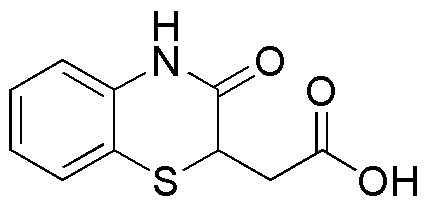3,4-Dihydro-3-oxo-2H-(1,4)-benzothiazin-2-ylacetic acid is widely utilized in research focused on:
- Pharmaceutical Development: This compound plays a crucial role in the synthesis of novel drugs, particularly in the development of antibacterial and antifungal agents, addressing the growing need for effective treatments against resistant strains.
- Biochemical Research: It is used in various biochemical assays to study enzyme interactions and metabolic pathways, helping researchers understand complex biological processes.
- Analytical Chemistry: The compound serves as a standard reference material in chromatography and spectroscopic techniques, ensuring accurate identification and quantification of similar compounds in complex mixtures.
- Material Science: It is explored for its potential applications in creating advanced materials with unique properties, such as improved thermal stability and enhanced mechanical strength.
- Environmental Science: The compound is investigated for its ability to degrade pollutants, contributing to efforts in developing sustainable solutions for environmental cleanup.
General Information
Properties
Safety and Regulations
Applications
3,4-Dihydro-3-oxo-2H-(1,4)-benzothiazin-2-ylacetic acid is widely utilized in research focused on:
- Pharmaceutical Development: This compound plays a crucial role in the synthesis of novel drugs, particularly in the development of antibacterial and antifungal agents, addressing the growing need for effective treatments against resistant strains.
- Biochemical Research: It is used in various biochemical assays to study enzyme interactions and metabolic pathways, helping researchers understand complex biological processes.
- Analytical Chemistry: The compound serves as a standard reference material in chromatography and spectroscopic techniques, ensuring accurate identification and quantification of similar compounds in complex mixtures.
- Material Science: It is explored for its potential applications in creating advanced materials with unique properties, such as improved thermal stability and enhanced mechanical strength.
- Environmental Science: The compound is investigated for its ability to degrade pollutants, contributing to efforts in developing sustainable solutions for environmental cleanup.
Documents
Safety Data Sheets (SDS)
The SDS provides comprehensive safety information on handling, storage, and disposal of the product.
Product Specification (PS)
The PS provides a comprehensive breakdown of the product’s properties, including chemical composition, physical state, purity, and storage requirements. It also details acceptable quality ranges and the product's intended applications.
Certificates of Analysis (COA)
Search for Certificates of Analysis (COA) by entering the products Lot Number. Lot and Batch Numbers can be found on a product’s label following the words ‘Lot’ or ‘Batch’.
Numéro de catalogue
Numéro de lot/série
Certificates Of Origin (COO)
This COO confirms the country where the product was manufactured, and also details the materials and components used in it and whether it is derived from natural, synthetic, or other specific sources. This certificate may be required for customs, trade, and regulatory compliance.
Numéro de catalogue
Numéro de lot/série
Safety Data Sheets (SDS)
The SDS provides comprehensive safety information on handling, storage, and disposal of the product.
DownloadProduct Specification (PS)
The PS provides a comprehensive breakdown of the product’s properties, including chemical composition, physical state, purity, and storage requirements. It also details acceptable quality ranges and the product's intended applications.
DownloadCertificates of Analysis (COA)
Search for Certificates of Analysis (COA) by entering the products Lot Number. Lot and Batch Numbers can be found on a product’s label following the words ‘Lot’ or ‘Batch’.
Numéro de catalogue
Numéro de lot/série
Certificates Of Origin (COO)
This COO confirms the country where the product was manufactured, and also details the materials and components used in it and whether it is derived from natural, synthetic, or other specific sources. This certificate may be required for customs, trade, and regulatory compliance.


